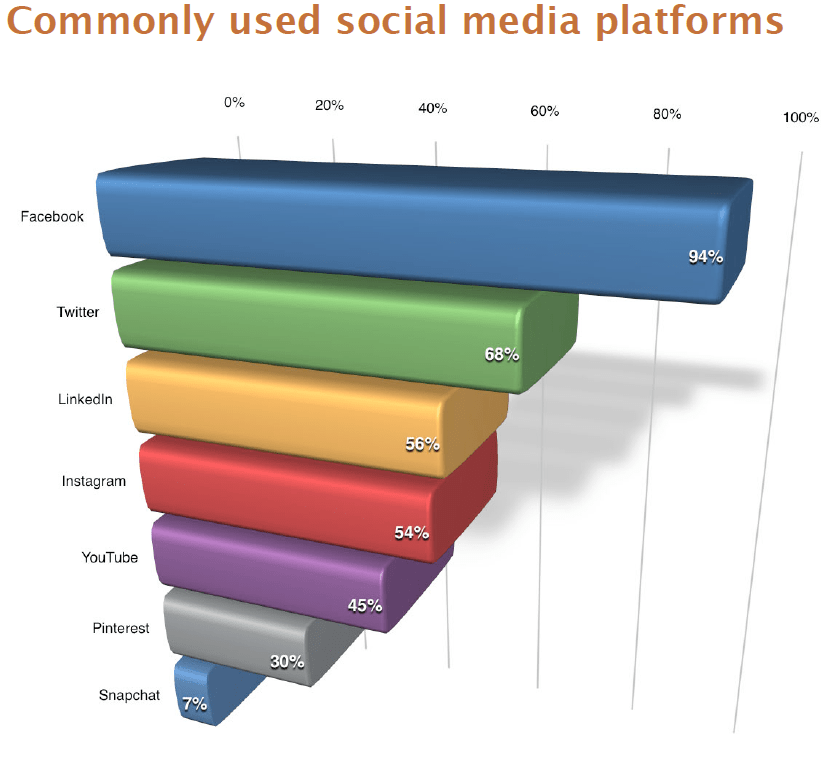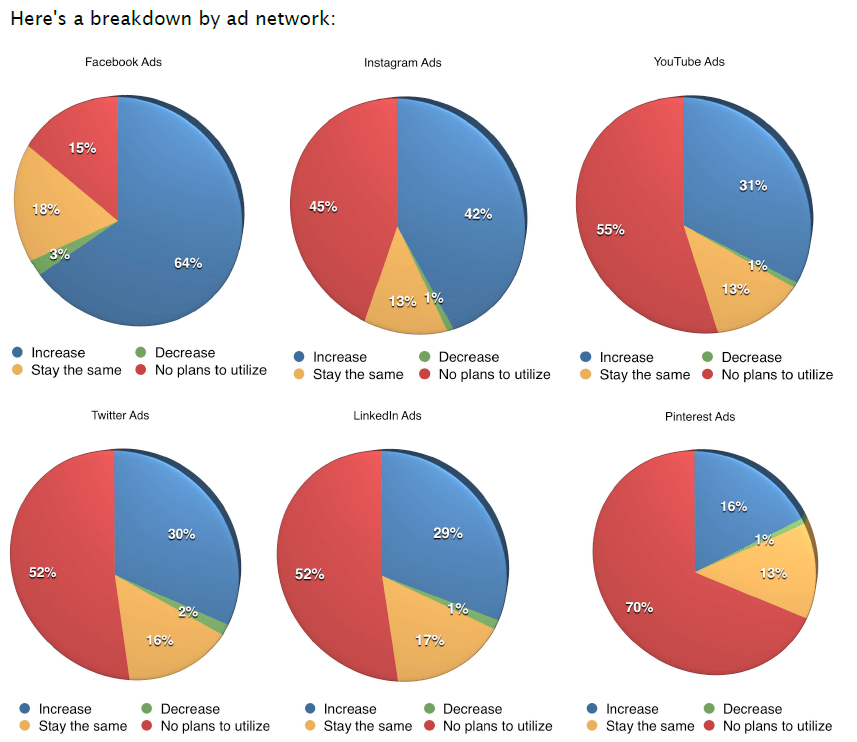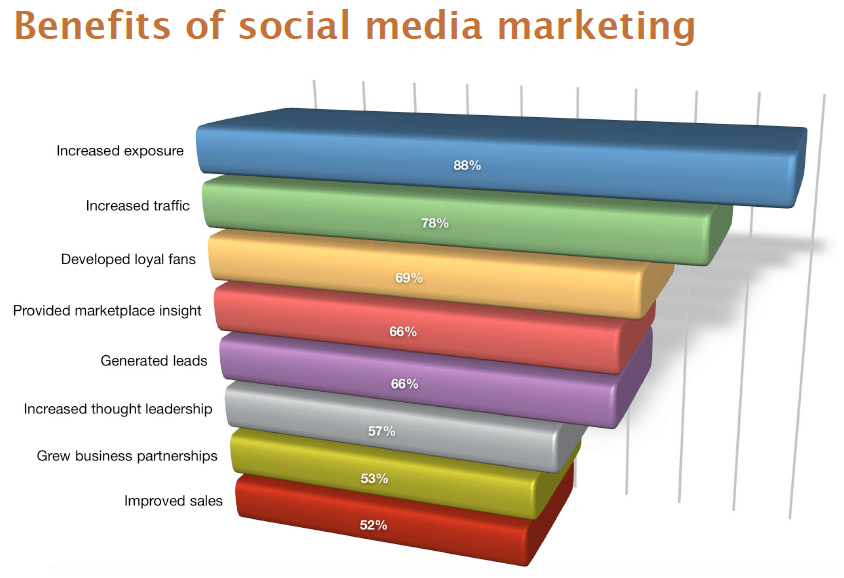
Who, what, where, when and why of current social media marketing
I’m a big believer in nonprofits borrowing from for-profit marketing research (they have more money to spend!). So I was excited to take a peek into the recently released 2017 Social Media Marketing Industry Report commissioned by Social Media Examiner.
If you think for-profit marketing insights don’t apply to you, think again. You compete in the same space for audience attention!
Stop being satisfied with lagging behind your for-profit brethren. Get a head start on your social sector competition by reading the full 49-page report.
Don’t have time now? I’ve got you covered with this quick look at what’s happening in the world around you.
Here are the highlights:
Today’s Social Marketing Platforms

Social Media Examiner
There’s such rapid evolution in this area, it’s important you monitor your engagement to see where most of your traffic and engagement come from. For those in the study, Instagram saw the biggest jump, followed by Snapchat and Facebook.
CHANGES SINCE 2016
- Facebook rose from 93% to 94% in 2017.
- Twitter declined from 76% to 68% in 2017.
- LinkedIn dropped from 67% to 56% in 2017.
- Instagram jumped from 44% to 54% in 2017.
- YouTube declined from 53% to 45% in 2017.
- Pinterest dropped from 40% to 30% in 2017.
- Snapchat rose from 5% to 7% in 2017.
Tomorrow’s Social Marketing Platforms
- Facebook wins by a long shot. 62% say this is their most important platform. 93% of social marketers regularly use Facebook ads and 64% plan to increase their advertising activity. Yet… they’re not necessarily tracking the return on their investment (see below under “Whether Facebook is still working.”)
- LinkedIn is the next most important platform, with 16% choosing this as their number one. 48% of Business to Consumer (B2C) marketers plan to increase their Twitter activity in the coming year. For nonprofits, this is a good place for finding and building relationships with potential major donors, and also for establishing your brand authority.
- Twitter clocked with 9% saying it’s their first place choice. 56% plan to increase Twitter activity over the next year.
- Instagram is on a growth trajectory. 7% picked it as their first choice. Currently 54% of marketers are using it; 68% of B2C businesses plan to increase their use of it. 24% plan to use Instagram ads moving forward. It’s a great platform for visuals, which is a marketing trend.
- Pinterest, while losing ground to Instagram, is still where 40% of B2C business will increase posting frequency. 55%, however, have no plans to use it (compared with 22% who will not use Instagram).
The three platforms B2C businesses most want to learn more about are: Facebook (84%), Pinterest (52%), and Instagram (76%).

Social Media Examiner
For a look at what another social media marketing guru suggests, take a look at The 3 Social Networks That Matter to Your Business and Why by Rebekah Radice.
When it comes to your own nonprofit, don’t (1) continue doing what you’ve always done just because you’ve always done it, or (2) do what your for-profit brethren do just because it works for them. (40% don’t know if their Facebook efforts, for example, are even working).
Frequency of Posting to Major Social Platforms
On average, social marketers post this frequently on these platforms:
- Facebook – 8X/day
- Twitter – 6X/day
- LinkedIn – 4X/day
- Instagram – 4X/day
- Pinterest – 3X/day
- Snapchat – 1X/day
Don’t become discouraged if your activity falls below these for-profit benchmarks. You can still get an idea of relative importance. Begin with that; then measure your return on investment (cost/benefit) and engagement (clicks, click-throughs, time spent on page, shares, advocacy actions, sales, donations) over time in order to plan intelligently for the coming years. Quality comes before quantity.
Top Benefits of Social Media Marketing and How Time Invested Affects Results
The top benefits overall are increased exposure and increased traffic. 88% of all marketers indicated their social media efforts have generated more exposure for their businesses. Increasing traffic was the second major benefit, with 78% reporting positive results. Most marketers use social media to develop loyal fans (69%) and gain marketplace intelligence (66%).

Social Media Examiner
More than half of marketers who’ve been using social media for more than two years report it helped them improve sales. More than half who spend 6 or more hours per week find the same results. I would guess this would apply to fundraising as well. Do you feel that use of social media is improving fundraising results?
Benefits change depending upon how long you’ve been engaged and how much time you put into it. For people just beginning with social media (less than 12 months of experience), 51% spend 5 or fewer hours per week. Not surprisingly, they reap the fewest benefits. But benefits are still significant. Among those who’ve been doing this for 2 years or longer, at least 65% spend 6 hours or more per week on social media activities; 41% spend 11 hours or more weekly. Nearly 20% of marketers spend more than 20 hours each week on social media.

Social Media Examiner
Most Common Forms of Content for Social Media Marketing
- Visuals 85% of marketers use them (up from 74% last year), and 73% plan to increase use of visuals. A helpful article on how nonprofits can focus on the visual elements of their social strategy is 5 Ways to Get Visual on Social Media.
- Blogging is used by 66% of marketers. It’s the second most used form of content, and 65% plan to increase in this area.
- Video is used by 57%. 75% plan to increase video use.
- Live video is hot. It’s used by 28%, up from 14%. Significantly, 61% plan to use live video services (e.g., Facebook Live and Periscope) in the coming year. For nonprofits, this is a great opportunity to tell stories with your videos. Help your donors to see themselves in your stories (as the hero!), and make them compelling and easy to share. That’s how you’ll drive even greater awareness and engagement.
When marketers were asked to choose only one form of content as their favorite, video ruled and blogging followed.

Social Media Examiner
- If you want to learn more about nonprofit blogging, grab my Nonprofit Blogging that Drives Engagement Playbook.
- If you want to learn more about making videos, download this free Guide to Video Marketing from Animoto. It’s a little fancier than what you can do on your smartphone (which is a perfectly acceptable tool today!), and it’s easy enough for even me to follow.
Key Issues and Areas To Master Moving Forward
- 93% of marketers want to know more about the most effective social tactics. As changes continue to occur at a rapid pace, keeping an ear to the ground becomes increasingly important. If you rest on your laurels, the world may pass you by.
- 91% want to know best ways to engage their audience with social media. They realize this is where you gain your competitive advantage.
- 89% want to know how to measure their ROI from social media activities. Learn how and what to measure here from Steven Shattuck of Bloomerang.
- 88% want to know the best ways to use paid social media. Learn how nonprofits can succeed with paid ads here from Julia C. Campbell of J. Campbell Social Marketing.
- 85% want to know how to find their target audience with social media. Learn more about this here.
- 74% want to learn more about Facebook Messenger and similar apps. Learn about Facebook fundraising tools here.
- 67% of B2C marketers want to learn more about making videos. See some compelling nonprofit videos here, curated by the folks at Classy.
- 61% want to learn more about virtual reality and 360-degree video. See one use of virtual reality for nonprofits here.
- 57% of B2C marketers are interested in learning about artificial intelligence and bots. See how artificial intelligence can drive impact for nonprofits here.
The Bottom Line
92% of marketers said social media is important to their business. That’s huge. If you’re treating social media as something that’s not really necessary, it’s time to rethink.
Moving forward, you need a documented strategy for employing social media to support your work.
- Find the network where your audience spends the most time. You can do this with a quick (and free) Survey Monkey survey. Start there.
- Begin experimenting more with the most popular forms of content: video, visuals and blogging.
- Measure your return on investment (ROI) and engagement (ROE).
- Keep revising your plan by using your metrics and keeping up with industry trends.
Social media is the new nonprofit advertising, but that doesn’t mean the content you serve up should always be “ads.” Your audiences want relevant content that’s so interesting and compelling it inspires them to share and become your advertisers. When you can make this happen, your ROI and ROE will more than justify your investment.

Please join me on the pathway to passionate philanthropy!
If you’re enrolled as a ‘Clairification School‘ student, check out all my articles about nonprofit social media in the archives. Not yet enrolled? Please listen to my pal Cindi.

With your support, Clairification will continue to be here for everyone. Thank you! (and thanks Cindi!)




Fantastic information here! Social media is such a powerhouse for getting your organization’s name and story out to the world. With so many different channels, though, it can seem overwhelming to start a social media campaign from scratch. Luckily, many of the platforms are easy to use and master quickly, even if you don’t consider yourself a tech guru! Making your organization a thriving social media campaign can only help you reach your goals! Thanks for sharing these insights!